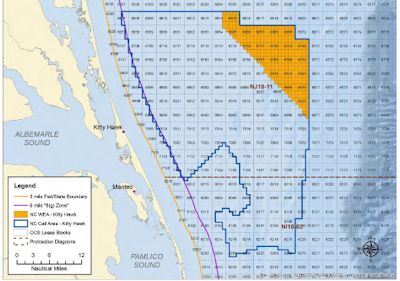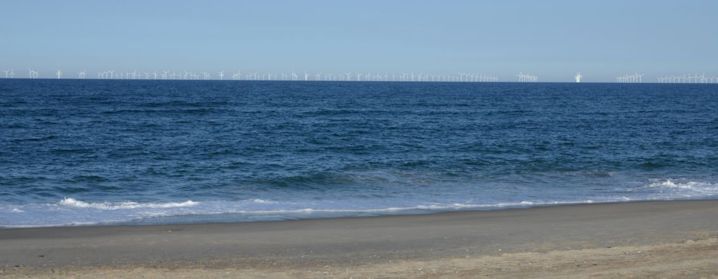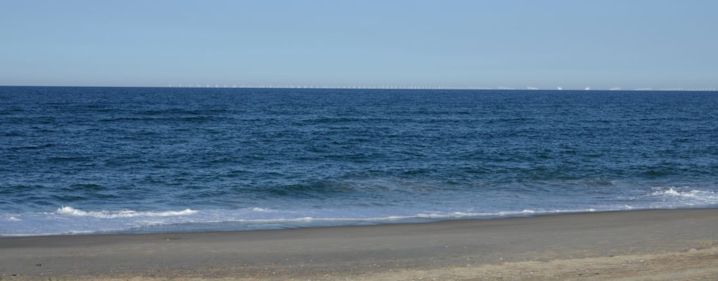
KITTY HAWK — Meetings to discuss potential offshore energy production are nothing new for Outer Banks residents, but this time the energy source is not hydrocarbons, and residents are not united in furious opposition.
Still, the presentation held Monday evening in Kitty Hawk about a possible wind energy project offshore the northern Outer Banks spurred familiar concerns.
Supporter Spotlight
“Our precious commodity here is tourism,” said Tim Cafferty, vice-chairman of the Dare County Tourism Board. “It’s a half-billion dollar industry on the Outer Banks. What’s in it for us?”
The federal Bureau of Ocean Energy Management, formerly the Mineral Management Service, is seeking public input on an environmental assessment of leasing tracts 24 nautical miles off Kitty Hawk for commercial wind energy. It is a significant first step in the process, but construction, if approved, would be many more steps down the road.
Comments will be accepted through Feb. 23.
Considering the light attendance at previous BOEM workshops on the Outer Banks, agency staff expressed surprise on Monday that about 60 people showed up, although only a handful asked questions or commented.
In responding to Cafferty, Brian Krevor, environmental protection specialist in BOEM’s Office of Renewable Energy Programs, said that feedback provided during early workshop sessions in the community is reflected in the study.
Supporter Spotlight
“We take the tourism concerns very seriously,” Krevor said.
Krevor said that in the summer months, the sky is hazier, which would make turbines less likely to be visible from the beach.
Although the study did not look at the height or number of turbines that could be built at the Kitty Hawk site, Krevor said, in general turbines, equipped with hazard lights, can range from 450 feet to 600 feet high. The project would also include at least one meteorological tower that would likely be about 400 feet high, or a 30-foot-tall buoy. The developer will tailor the wind turbines and other technology to the available wind resources at the site.
In the late 1980s, Mobil Oil Corp. had leased tracts off Cape Hatteras to explore for oil. About 10 years later, Chevron USA proposed a similar project. Public resistance was fierce in both instances. Although both efforts were eventually dropped, offshore oil and gas exploration off the Atlantic coast was recently proposed by the Obama administration, with leases starting in 2017.
But now offshore wind energy development is ahead in line – although no project will be a slam-dunk. In addition to Kitty Hawk, two other lease sales are proposed off Wilmington. There are no wind farms in U.S. waters, and there are currently no active oil and gas lease units in the Atlantic.


BOEM is planning to hold two public meetings this month on the offshore oil and gas proposal. So far, none are scheduled on the Outer Banks, although local governments have requested that one be held.
Land-based wind projects have had explosive growth, and ocean projects look poised to follow. Since 2009, BOEM has issued seven commercial wind energy leases: Cape Wind, off Massachusetts; Bluewater Wind Delaware, off Delaware; Deepwater Wind New England with two leases off Rhode Island and Massachusetts; Dominion Virginia Power, off Virginia; and U.S. Wind Inc. with two leases off Maryland. All are in different stages of permitting, but Block Island off Rhode Island may be the closest to construction.
In addition to North Carolina, planning for offshore wind projects has begun in New York, South Carolina, Oregon and Hawaii. Lease sales were held in January in Massachusetts and a lease auction is being planned in New Jersey.

According to CleanTechnica, a web-based advocacy group, the U.S. wind industry grew 28 percent in 2012, when 45,100 wind turbines were installed. The top nation in the world for wind-power capacity is Denmark, the site said, followed by Spain, Portugal, Sweden and Germany. China and the United Kingdom are also major producers of wind power.
Initially, the proposed site in Kitty Hawk was as close as six miles off the beach. But in response to the town’s opposition to any project less than 20 miles from shore, the lease unit area was moved further offshore. The overall size was also decreased to stay 34 miles from the historic Bodie Island Lighthouse, part of the Cape Hatteras National Seashore.
Other modifications reflected in the environmental assessment addressed boat traffic and the migratory patterns of marine mammals, birds, fish and turtles.
The reconfigured Kitty Hawk wind energy area is carved into about 21.5 “blocks,” or lease units. It extends about 26 nautical miles north to south and encompasses 122,405 acres. A 33.3-nautical mile cable would be run underground to the shore.
No position for or against the proposal has yet been taken by the town of Kitty Hawk or Dare County. Gov. Pat McCrory has been supportive of wind energy production in North Carolina as part of an “all-of-the-above” approach to energy, though his office was silent when BOEM announced the proposed lease sales. McCrory issued a statement a week later when the oil leases were announced.
Zachary Keith, a lead organizer for the Sierra Club’s N.C. chapter, said after the meeting that wind energy is generally met with support in communities.
Keith also said that he has been pleased to see how the industry and government have worked cooperatively to address the possible environmental effects of wind projects.
“I’ve never seen an anti-offshore wind rally,” he said. “Everything I’ve ever been to has been positive, or at least cautiously positive.”

Addressing one question that was raised during the meeting about whether the wind project would receive government subsidies, Keith said that a more correct term is tax credits, similar to what is provided to other energy industries.
Those federal tax credits, which are due for renewal, have helped spur innovation and investment in a growing technology, he said.
“I think what the (wind) industry wants is a level playing field,” Keith said, adding that periodic threats of losing the credits discourages long-term investment. “There’s no market certainty.”
Offshore development on the Outer Banks could lead to more well-paying jobs for the area and academic opportunities for worker training, Keith said. And it would feed clean energy into the power grid.
“Kitty Hawk seems small,” he said, “but it actually represents a fairly large area.”
According to Chris Carnevale, coastal climate and energy coordinator with the Southern Alliance for Clean Energy, the wind energy potential in the Kitty Hawk area is about 2,475 megawatts. In general, he said in an e-mail, 1,000 MW of offshore wind energy would power about 225,000 Southern homes. For comparison, he added, a new nuclear power plant produces about 1,100 MW of energy, although the energy it produces is more constant.
Several people at the workshop who asked about the timeline of the wind project were met with vague generalities, mostly because of the numerous variables that come into play.
“There’s a very step-by-step process,” said William Waskes with BOEM. “That lease gives you a right to submit a plan.”
Commercial fisherman Daniel Cohen, spurred by climate change and the need for renewable energy, organized fishermen on the Eastern seaboard to start Fishermen’s Energy. The company has expressed interest in building a wind farm off the N.C. coast.
After public comments are reviewed, BOEM will decide to revise the assessment; publish a finding of no significant impact; or issue an intent to do a more involved Environmental Impact Statement. But Krevor said after the meeting that the process is expected to be wrapped up this year.
By next year, leases should be ready to be offered. A proposed sale notice would be drafted, followed by a 60-day comment period, a review period and the final sale notice. If leases are issued for commercial wind energy towers, a construction and operations plan and a site-specific environmental analysis will be required. A lessee has 25 years to construct the wind project and generate electricity.
Five companies have expressed interest in all three North Carolina projects: Apex Clean Energy, EDF Renewable Energy, Fishermen’s Energy, Green Sailene and Dominion Power North Carolina. But Dominion has “nominated” only selected lease blocks in Kitty Hawk, Krevor said.







